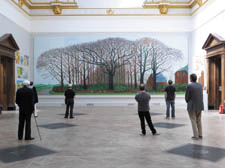|
|
 |
| |

Hockney’s Bigger Trees Near Water and, top, Michael Sandle’s triptych |
The naked and the dead
Gerald Isaaman wanders – and wonders – round this year’s Royal Academy Summer Exhibition
FIRST impressions always count. So when you see three giant dinosaurs towering above the classical courtyard entrance to the Royal Academy, you wonder if you are entering some theme park rather than the home of British art, the simplistic works in rusting Corten steel by Jake and Dinos Chapman unworthy of such a setting.
Then, once inside, you almost immediately come across a set of five skeleton drums and cymbals, a skinned, cut-down drum kit by Richard Wilson RA, which exposes the vacuum too much art represents today.
Ironically, the work is called Traps, no doubt symbolic of the feeling this year’s summer show too often evokes as you wander – and wonder – round the galleries.
So much seems devoid of substance, irrational and illogical, representing the confused, dysfunctional and visionless age we live in.
Perhaps on that score it strikes home, the Summer Exhibition being, after all, the world’s largest open submission contemporary art exhibition. Some 13,000 works were entered this year, and the end result is a mismatch of the weighted and way-out work of RAs and often unknown members of the public, who can produce tiny prints of a pig that sport red “sold” stickers or truly imaginative works.
In the end, as in previous years, it is the work of the architects which demands respect for innovation and delight, as modern technology allows them to throw off the restrictions of common structures and produce designs for buildings that mesmerise.
The model for Prague’s new library by Future Systems, basically a helmet-shaped building punched through with holes for its windows, is immediately exciting.
Chris Wilkinson has produced a wondrous House of Human Rights. The wave-like roof section for a new terminal in Madrid, the work of Lord Rogers, equally makes you hold your breath.
There is innovation in the art, too. The show offers the Royal Academy’s first tentative foray into the world of photography, dedicated to the theme of ‘light’ that pervades the exhibition, and which includes the clever and colourful work of Catherine Yates and Paul Graham.
And then, of course, David Hockney demands attention with the largest painting ever shown at a Summer Exhibition, a huge landscape of trees 40ft wide by 15ft high, which Hockney painted in the open air.
When it comes to painting technique, you have the admire Islington View by Melissa Scott-Miller, who lives in Lonsdale Square. Here is the urban landscape of back gardens, bricks and trees, windows and fences acutely observed and brilliantly painted.
Scott-Miller’s contribution stands out among the unknowns and those RA regulars such as Tom Fairs, of Steeles Road, Hampstead, and Norman Miller, of Willes Road, Kentish Town, whose intimacy and passion glow even in the gloom of some of their subjects.
The Hampstead artist Michael Kidner gives us a taste of the bewilderment of war with two coloured pencil drawings dedicated to Iraq and Michael Sandle puts Tony Blair and Cherie naked on the doorstep of No 10 in his charcoal and chalk Iraq Triptych, which lacks clarity and true satirical clout.
It is in paying tribute to artists who have passed on that the Summer Exhibition reminds us of the immaculate abstract imagination of Sandra Blow (1925-2006) and the solid, resolute standards of Kyffin Williams (1918-2006). You can literally lick the snow off the rooftops in his Welsh landscapes.
So it is not surprising that he totally rejected the conceptual art of celebrity artists such as Tracey Emin.
“He knew that many found him irritable, and admitted that he was ‘an obsessive, depressive, diabetic epileptic, who’s apprehensive, selfish, intolerant and ruthless’, as the RA catalogue reminds us.
Yet he was warm and wise and witty – and a great teacher during his years at Highgate School, where he nurtured the talents of Anthony Green RA, whose ingenuity and wit are currently on display at the academy, and the late Patrick Procktor.
As Green has said of his tutor’s work: “Tomorrow the art galleries and museums will have to stand in line to buy for the nation. History will vindicate the man and his artistic language.”
Perhaps a new tradition as accessible and admired as that of Kyffin Williams will emerge in the 21st century. Alas, it is not easily discernible among the reckless styles and estranged subjects all too evident in the lacklustre summer show today.
|
 |
|
| |
|
 |
|

